Hagia Sophia is a former basilica, later a mosque, then Museum, Now again converted into Mosque in 2020. Famous in particular for its massive dome, it is considered the essence of Byzantine Architecture and one of the most beautiful buildings in the world. It was designed by two architects Miletus and Anthemius of Tralles.
In 1453, Constantinople was conquered by the Ottomans, the Turks, and Sultan Mehmed II, who ordered the building to be converted to Islam. The idols, the altar, the iconostasis, and the sacrificial vessels were removed, and most of the stone objects were eventually attached. Islamic features, such as the four outer minarets, the mihrab, and the minbar, have been added to the continuation of its history under the Ottomans. It remained as a mosque until 1935 when it was converted into a museum by an international republic of the Republic of Turkey.
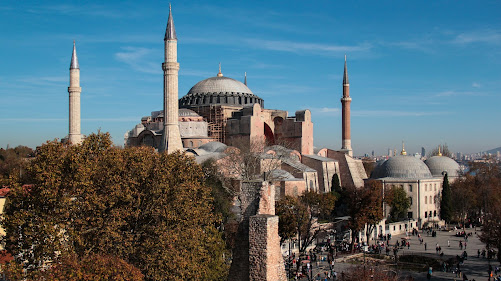 |
Hagia Sophia |
For nearly 500 years Istanbul's main mosque, Hagia Sophia served as a model for many Ottoman mosques such as the Sultan Ahmed Mosque, the Sehzade Mosque, the Squeemaniye Mosque, and the Pasha Pasha Mosque.
Architecture :
Hagia Sophia is one of the heaviest examples of Byzantine architecture, both architectural and religious. Its broad nave is covered with a medium-sized upper bone made of pendentives. Pandentives form possible dome support on a square frame of equal arches that reside on large pillars. The arches at east and west are extended by great half domes, while the half domes, in turn, carried on smaller semi domed exedrae.
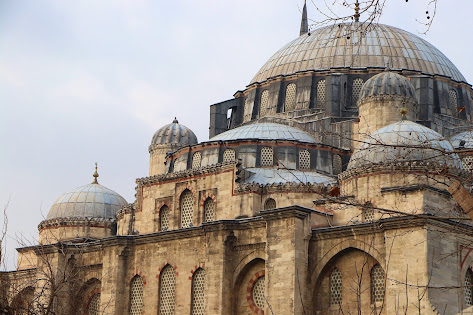 |
Architecture |
At the east end of the temple house, there is a storehouse on the west and finally on the west a large narthex. Surrounding the nave to the north and south are sidewalks with porches above them. Their massive vaults, carried at both levels by columns of green and white marble.
Dome :
The vast nave is covered by a central dome which has a maximum diameter of 31.24 meters and a height from the floor level of 55.60 meters. The dome looks weightless with an endless arcade of 40 windows below it, helping to flood the colorful interior with light.
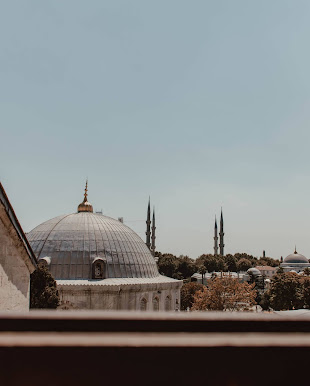 |
Dome |
The dome is made of the pendant, the four triangular stone structures that solve the problem of laying a circular base of the dome on a rectangular base. In Hagia Sophia, the weight of the dome passes from the pendant to the four main poles in the corners. Among them, the dome appears to run over four huge arches.
All interiors surfaces are sheathed with polychrome marbles, green and white with purple and gold mosaics, covered on the brick. On the exterior, simple stucco walls reveal the clarity of massed vaults and domes.
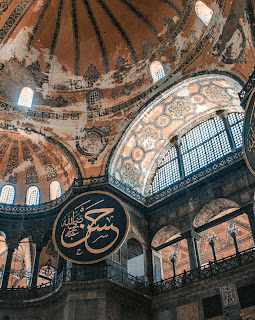 |
Interior of Dome
|
Minarets :
One of the Minarets was built from red brick while the other three were built from white limestone and sandstone.
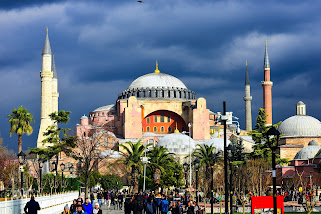 |
Minarets
|
Lustration Urns :
Two huge marble lustration urns were brought from Pergamon during the reign of Sultan Murad III. Stemming from the Hellenistic period, they are carved from single blocks of marble.
Narthex and Portals :
The Imperial Gate was the main entrance between the exo- and exonarthex. It was reserved only for the emperor. The Byzantine mosaic above the portal depicts Christ and an unnamed Emperor. A long ramp from the northern part of the outer narthex leads up to the upper gallery.
Upper Gallery :
The upper gallery is laid out in a horseshoe shape the encloses the nave until the apse. Several mosaics are preserved in the upper gallery, an area traditionally reserved for the empress and her court.
Loge of the Empress :
The loge of the empress is located in the center of the upper enclosure, or gallery, of the Hagia Sophia. From there the empress and the court ladies would watch the proceedings down below. A round, green stone marks the spot where the throne of the empress stood.
Marble Door :
The marble door inside the Hagia Sophia is located in the southern upper enclosure or gallery. It was used by the participants in synods, they entered and left the meeting chamber through this door.
Decorations :
Originally the interior decoration consisted of abstract designs of the marble slab on the walls and mosaics on the curving vaults. There were already figurative decorations. The spandrels of the gallery are revetted in opus sectile. showing patterns and figures of flowers and birds in a cut piece of white marble, set again the background of black marble.
Mosaics:
Imperial gate mosaic located in the tympanum above the gate used only by the emperors when entering the church. It represented the emperor Leo VI bowing down before Christ Pantocrator, giving His blessing and holding in his left hand an open book. These mosaics express the timeless power bestowed by Christ on the Byzantine emperors.
Southwestern entrance mosaics, situated in the tympanum of the southwestern eastern, date from 944.
They were rediscovered during the restorations of 1849 by Fassati. The Virgin sits on a throne without a back, her feet resting on a base, embellished with precious stones. The child christ sits on her lap, giving His blessing and holding a scroll in His left hand.
Empress Zoe mosaics on the eastern wall of the southern gallery date from the 11th century. Following the building converted into a mosque in 1453, many of its mosaics were destroyed or covered with plaster, due to Islam's ban on representational imagery. This process was not completed at once, and reports exist from the 17th century.
Stay tuned for more informative blogs. Thank you.









It's so informative.
ReplyDeleteGreat
ReplyDelete👍🏻
ReplyDeleteGreatt
ReplyDelete